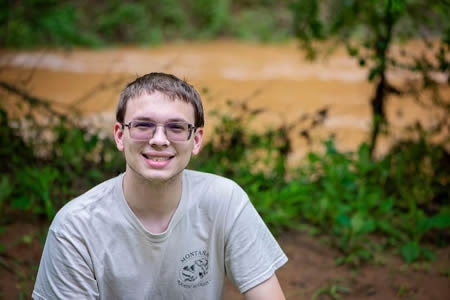SFA University

Zachary Hutchens, a student in Stephen F. Austin State University’s Department of Biology, was recently awarded the Student Field Natural History Award by the Southwestern Association of Naturalists for his work studying the Sabine shiner in the Lanana Creek watershed.
June 4, 2021 — For the past nine months, an SFA biology student has ignored unforeseen weather extremes and other hurdles to wade into the waters of Banita and Lanana creeks in search of a threatened fish – the Sabine shiner. The Southwestern Association of Naturalists recently recognized his efforts with the Student Field Natural History Award.
Zachary Hutchens, a senior from Nacogdoches, is conducting research to assess the status and habitat conditions of local populations of Sabine shiner in the Lanana Creek watershed.
“In winter and summer sampling trips, we face extreme conditions, such as freezing and scorching temperatures,” Hutchens said. “Regardless of the weather, we maintain a consistent sampling schedule in order to standardize our data collection.”
The Sabine shiner is a small fish found in clear, shallow streams and is currently classified as a Species of Greatest Conservation Need in Texas, necessitating a need for tracking its geographic distribution in East Texas waterways.
Using a seine, Hutchens and his faculty mentor, Dr. Carmen Montaña, assistant professor in the Department of Biology, collect the fish and mark them with visual implant elastomer tags to study their movements in the creeks.
“It is a species lacking research into their movement patterns,” Hutchens said. “My project has shown that there is an isolated population of the Sabine shiner in Banita Creek, and it does not move very far from the tagging location.”
Because the last study on the fish was conducted 20 years ago, Hutchens’ research will provide a much-needed update.
“That study reported a much higher abundance and stable populations of Sabine shiner compared to what we are finding today,” he said. “This presented a great opportunity to investigate exactly how much this population has changed and search for reasons as to why.”
Once collected, results from Hutchens’ study will be compared to the previous study.
“As a faculty member and a mentor, I am proud of our students,” Montaña said. “They work very hard in the field and lab settings to produce quality scientific data and increase their involvement with scientific research.”
Hutchens recently presented his research to judges, students and other scientists at the 68th annual meeting of the Southwestern Association of Naturalists where he was recognized for his outstanding oral presentation and the strong field component in his research.
“This conference gave students a platform to present their research to a diverse group of scientists and graduate and undergraduate students working in the fields of ecology and conservation,” Montaña said. “Their participation in this meeting allowed our students to grow as scientists.”
To learn more about the Department of Biology, visit sfasu.edu/biology.
May 25, 2021 – Chartwells Higher Education, a food-service company providing dining options to 300 higher education institutions around the country, will begin preparing and serving meals to Stephen F. Austin State University Lumberjacks July 1, replacing Aramark.
Chartwells is the food service provider for several Texas universities, including Texas State University, the University of Texas at Dallas and Texas A&M University at College Station.
The decision for SFA to transition to Chartwells came after a request for proposal and a thorough selection process that included input from students, faculty, staff and administrators.
SFA’s Board of Regents reviewed feedback submitted by the RFP evaluation committee during its quarterly meeting in April and selected Chartwells as its preferred partner. The partnership will provide added meal plan flexibility, greater menu variety and an innovative retail dining experience. SFA’s contract with Chartwells will last seven years.
“Cooked-from-scratch foods, menus developed by season, supporting farmers by sourcing locally, and offering vegan, vegetarian and allergen-friendly options are all trademarks of Chartwells,” said Carrie Charley, SFA director of auxiliary services. “The new dining program will be rebranded as Lumberjack Eats, representing a fresh, student-centric approach to campus dining. Lumberjacks can look forward to a refreshed dining experience with new dining stations in the Baker Pattillo Student Center and East College Dining Hall.”
“The G8 station will be a fresh addition to both dining halls,” Charley said. “It will offer menu selections prepared without the eight major allergens, including wheat. Throughout the dining halls, Chartwells’ menu and nutrition labeling system will help guests make safe and healthy choices.”
For fall, students can expect to see their favorite national brands, including Chick-fil-A, Starbucks and Einstein Bros. Bagels. New additions to retail dining include Jax Burger, serving burgers, tots and shakes, and Above the Board, featuring customizable, made-to-order salads and sandwiches.
All meal plans will remain the same in structure through June 2022. SFA and Chartwells will work collaboratively to develop future meal plan options that provide the best value and flexibility for SFA students, faculty and staff.
Hourly Aramark associates currently working at SFA will receive an employment offer from Chartwells that meets or exceeds their current wage, pending background check, Charley said. SFA will continue to have its own registered dietitian, whose services are free to students, and a new executive chef employed by Chartwells will work with SFA stakeholders to develop new menu items and dining options across campus.
“The SFA community can look forward to a culinary experience that emphasizes quality, made-to-order food, menu customization and value,” said Shannon Mariani, regional vice president for Texas, Chartwells Higher Education. “With ongoing feedback from students and the SFA community, our chefs will create menus Lumberjacks will crave. Diverse and authentic flavors will be infused into stations, and scratch cooking will define the foundation of the dining program. Beyond the plate, we look forward to engaging guests with culinary education through our Teaching Kitchen program and creating memorable experiences through innovative dining events.”
Students are encouraged to apply for campus dining positions. Additionally, Chartwells will launch a Student Success internship program, which provides student access to hands-on work in community health and wellness, hospitality management, marketing, social responsibility and sustainability.
Chartwells also will explore partnerships with departments across campus to build greater opportunities for career exploration with Chartwells and Compass Group, Chartwells’ parent company.
Questions regarding SFA’s transition to Chartwells can be emailed to LumberjackEats@sfasu.edu or to Charley at carrie.charley@sfasu.edu.
May 21, 2021 – Select fine arts summer camps at Stephen F. Austin State University are back for 2021.
The School of Art will offer its Educators’ Summer Art Studio for high school, middle school, elementary and community college educators, according to Dr. Bill Nieberding, professor of art and coordinator of the session.
The studio experience offers a unique opportunity for teachers interested in the arts to work with professional artists using a variety of media and processes to explore shared experience and develop community among Texas arts educators. Participants will explore media and processes applicable to the art classroom and develop and refine studio art-making practices toward a goal of creating pin-up exhibition in the art galleries on campus. Due to Covid and space limitations, the workshops must be limited to 16 participants who will be accepted on a first-come first-served basis. Residential and commuter options are available. For registration and payment option information, visit art.sfasu.edu/summerartstudio.
The Art Academy will not be offered this summer but will return in June 2022. The School of Art may be reached at (936) 468-4804.
The School of Music will offer a number of camps this summer in limited capacity. For registration information, visit music.sfasu.edu/outreach to select camp options and view pricing.
The High School Band Camp will be offered as an invitational honors band camp June 13 through 18. Student inclusion in the camp will be predicated on factors including nominations submitted by school band directors and instrumentation, and enrollment will be limited, according to Dr. David W. Campo, summer band camp director. High school band directors may learn more about the camp and nomination process at bandoffice@sfasu.edu .
Due to logistical limitations, middle school band camp will not be held this year.
Drum Major camp is scheduled for June 20 through 24, and information will be posted soon at music.sfasu.edu/outreach.
SFA’s All-State Music Choir camp is scheduled for July 11 through 14 for large schools and July 14 through 17 for small schools. On-campus lodging and commuter options are available. The camp is designed for ninth through 12th grade students preparing for the TMEA All-State choir auditions. For questions, contact Dr. Tod Fish, camp director, at fishtod@sfasu.edu.
Strings camp is slated for June 27 through July 3 with on-campus residential and commuter options available. The SFA Strings Camp welcomes junior high and high school students. Students are placed into an orchestra based on placement auditions via video submission before camp begins. Young students should have either been involved in their school programs for one year or have completed Suzuki book 1 in private lessons. For more information, email the camp director, Ruby Ortiz, at sfastringscamp@gmail.com.
The Piano in the Pines Camp is also back in an in-person format July 18 through 23. Eligible students must be between grades 6 and 12 in the fall of 2021. On-campus housing and commuter options are available.
Students will get an opportunity to have daily private lessons with one of the piano faculty, receive coaching on piano duets or ensembles, and take supplemental classes in technique and history to improve their overall musicianship. Performance classes will help students prepare for performing on stage in a supportive environment while individual time in practice rooms between lessons will be given to refine their repertoire. The week culminates in performing in a duet/ensemble concert on Thursday, and a final solo recital on Friday in one of SFA’s concert halls. For more information, email the camp director, Mario Ajero, at ajeromp@sfasu.edu, call (936) 468-1389, or visit sfasu.edu/pianocamp.
The School of Music may be reached at (936) 468-4602.
The School of Theatre will offer both in-person and online options for the Junior Jacks Theatre Camp planned for Aug. 2 through 6 and Aug. 9 through 13. Access registration information and pricing at theatre.sfasu.edu/programs.php. The High School Summer Theatre Workshop will not be offered this year.
Junior Jacks Theatre Camp was started in 2009 to serve local youth while offering an opportunity for SFA theatre teaching certification students to teach students that are younger than high-school age. It was designed as a day-camp version of the well-established High School Workshop program. Children participate in theatre games, memorize and rehearse parts and perform for family and friends at the end of the camp. It is open to children entering third through ninth grades. Contact CC Conn at conncs@sfasu.edu for additional information.
The School of Theatre may be reached at (936) 468-4003
May 20, 2021 – The 3rd Marine Aircraft Wing Brass Band will perform at Stephen F. Austin State University in a free concert at 5 p.m. Wednesday, May 26, in Cole Concert Hall in Wright Music Building.
The band of active-duty Marines is currently on a Houston-area tour under the direction of GySgt. Ken Ebo, who is also primary recruiter for the southeast region of the U.S. and is in charge of band auditions. Four additional Marine Corp recruiters will also be present at the concert.
For additional information, contact the School of Music at (936) 468-4602 or Sgt. Selena Benitez, Recruiting Station Houston, at (936) 203-2350.
May 11, 2021 - Individuals interested in aviation will soon have the opportunity to pursue a bachelor’s degree that leads to aircraft pilot certification at Stephen F. Austin State University, following approval by the Board of Regents during a specially called meeting Thursday.
The university plans to partner with an aviation training school to offering the new bachelor’s degree. Two aviation training firms responded to a request for proposals issued by the university, and HCH Aviation was selected as a partner.
“We are excited to partner with HCH and expand our academic offerings,” said Dr. Scott Gordon, SFA president. “The aviation program will be a win for our current and future students, our partners and the community.”
According to Dr. Judy Abbott, dean of the Perkins College of Education, the university will develop and implement the aviation science degree, and courses will be offered beginning in fall 2021.
“The students will begin their flight lab at the A.L. Mangham Jr. Regional Airport, located on State Hwy. 7 west of Nacogdoches,” Abbott said. “By the end of the semester, they will have approximately 45 flight hours accumulated.”
Regents also approved the cost for tuition and fees for students pursuing a Bachelor of Science in Interdisciplinary Studies through the university’s partnership with the Texas A&M System’s RELLIS Academic Alliance in Bryan-College Station. The partnership will appeal to a new group of transfer students for SFA, according to Dr. Danny Gallant, vice president for finance and administration.
“It’s a great opportunity for us to diversify our offerings in education,” Gallant said. “This is likely a group of students that we could not attract if we weren’t involved in this partnership.”
The tuition cost of $4,647.75 for a 15 semester credit hours is the same rate charged by other A&M institutions offering courses on the RELLIS campus. SFA’s program on the RELLIS campus will begin in fall 2021.
After an executive session, regents approved the acceptance of an invitation for SFA athletics to join the Western Athletic Conference in 2022. The WAC is currently home to California Baptist, Chicago State, Dixie State, Grand Canyon University, New Mexico State, Seattle University, Tarleton State, University of Texas Rio Grande Valley and Utah Valley University. Gordon will negotiate the terms of the agreement.
The regents also approved a reallocation of $200,000 that had been designated for computer acquisition and replacement. The funding will be used for security initiatives including an antivirus/endpoint protection solution, a multi-factor authentication solution and a self-service password reset portal. A portion of CARES Act funding will be used for critical computer replacements.
Regents authorized the SFA Charter School Board to approve the Audited Annual Financial and Compliance Report. The report is examined by an independent auditor and submitted annually to the Texas Education Agency.
For more information, visit www.sfasu.edu/regents.
May 10, 2021 - New students entering Stephen F. Austin State University may receive a housing scholarship of up to $3,000 per semester for up to two years.
The housing allowance program, recently approved by SFA’s Board of Regents, gives qualifying students even more reason to be part of SFA’s on-campus residential community, according to Dr. Brandon Frye, SFA vice president for student affairs.
“We want students living on campus,” Frye said. “Research shows the more engaged students are and the more active they are in university life, the better their chances for success.”
A new STEM Research and Learning Center quasi-endowment of $500,000 will provide funds to support student scholarships for students majoring in a STEM field within SFA’s College of Sciences and Mathematics. The funds also will support initiatives that reflect the teaching and learning mission of the STEM Research and Learning Center.
Based on the recommendation of a Campus Climate Steering Committee, regents approved a Diversity and Inclusion Statement to affirm the university’s commitment to creating an environment that respects, honors and values diverse experiences and perspectives.
The statement reads: At SFA, our commitment to diversity and inclusion is more than words—it is actions. We believe diversity and inclusion are keys to promoting more engaged individuals locally and globally. We at SFA are committed to amplifying a campus culture that nurtures belonging and embraces similarities while celebrating that every Lumberjack will be different. Those differences are valued, acknowledged and supported purposefully.
The 46-member committee includes faculty, staff, students and administrators.
“Our goal is to create welcoming learning environments and promote access and opportunity for all,” said Dr. Michara Delaney-Fields, SFA’s chief diversity officer.
Members of the board also approved a change in SFA’s food-service provider.
With objectives that include reimagining or replacing SFA’s East College Cafeteria and contributing to student satisfaction and enrollment growth, regents heard presentations by representatives with the current food service provider, Aramark, as well as competitors Chartwells Higher Education Dining Services and Sodexo.
A request for proposals for the food service contract, valued at approximately $73 million over seven years, was issued by SFA in November 2020. Aramark, Chartwells and Sodexo were the only three companies that submitted proposals.
Regents voted to authorize SFA President Scott Gordon to negotiate with Chartwells and, should the need arise, to subsequently enter into contract negotiations with Sodexo. Frye expressed appreciation to a committee of SFA employees, as well as Envision Strategies, an external consulting firm, for their assistance with the project.
“Student access and success are top priorities for SFA, and we look forward to working with the selected vendor, after the contract is finalized, to advance those priorities through our dining services program and services,” Frye said. “We will work to ensure a smooth transition to the selected vendor.”
Chartwells is the food service provider for several Texas universities including Texas State University, the University of Texas at Dallas and Texas A&M University at College Station.
Regents approved utilizing solely private donations to replace the turf and track at Homer Bryce Stadium and voted to name the field in honor of former SFA regent Jimmy W. Murphy. Regents also approved the naming of three areas in the Loddie Naymola Basketball Performance Center at William R. Johnson Coliseum: the Dr. Robert and Ruth Carroll Sports Medicine Offices, the Coach Harry and Tillie Miller Fan Observation Area, and the Joe Max and Jane Green Lobby.
Regents approved grant awards and a LaNana Trails campus project to reconstruct the trail on the university campus. The initiative is part of a Texas Department of Transportation project valued at more than $1.8 million, and SFA is contributing $362,255 as a 20% institutional match.
For more information, visit sfasu.edu/regents.
May 7, 2021 – Stephen F. Austin State University’s ROTC program recently competed in the national Sandhurst Military Skills Competition in West Point, New York.
The Lumberjack Ranger Challenge Team competed among 44 teams of national Army ROTC programs and U.S. military academy companies, including the University of Georgia, Texas A&M University and the United States Military Academy.
“Most of the other ROTC programs that competed had at least 150 cadets, compared to our 65 cadets,” said Lt. Col. James Attaway, SFA professor of military science. “Despite the size difference, we were able to prove we deserved to be there and compete.”
The two-day competition challenges cadets through myriad events, including obstacle course navigation, rifle marksmanship and more.
“I have been in the Army since 1998 and attended numerous schools, including Ranger School, parachute training, air assault training, and Survival Evasion Resistance and Escape,” said Attaway. “None of these schools did as much in one day as this competition forced these teams to do.
“For example, on the first day of competition, cadets ran approximately 27 miles in boots and a full kit, which includes a vest and weapons, while completing multiple functional fitness workouts and military tasks. Our cadets are willing to go above and beyond to prove they’re the best.”
Despite the trials of COVID-19, the Lumberjack Ranger Challenge Team diligently worked to prepare for the national competition. For months, cadets trained physically for the competition through functional fitness, cardio, swimming and weight training exercises. Cadets also were trained on a variety of tasks by SFA ROTC field instructors, including land navigation, first-aid preparedness, tying knots and obstacle courses.
By Emily Brown, marketing communications specialist at Stephen F. Austin State University.
May 3, 2021 - Stephen F. Austin State University’s horticulture program will host a spring plant sale from Noon to 2pm Thursday, May 6, and Friday, May 14, at the SFA Plantery, located at 1924 Wilson Drive.
“Our students have worked hard this spring growing a great crop of plants that will do well in East Texas,” said Dr. Jared Barnes, associate professor of horticulture at SFA’s Arthur Temple College of Forestry and Agriculture. “With this plant sale, we want to show off our student’s hard work in the greenhouses, as well as the opportunities offered through SFA’s agriculture department.”
Plants available for purchase include a variety of houseplants, succulents, tropical plants and spring annuals. All proceeds support future educational projects in SFA’s horticulture program.
COVID-19 protocols will be in place to help ensure a safe shopping environment. Social distancing and face coverings are required.
For more information, contact Barnes at (936) 468-7850 or barnesj@sfasu.edu. The community also may learn more about the horticulture program by visiting www.horticultureisawesome.com/the-plantery or following @sfahorticulture on Instagram.
April 29, 2021 - Stephen F. Austin State University will hold seven commencement ceremonies for May 2021 to accommodate measures aimed at ensuring attendee safety.
May and August 2020 graduates are invited to participate in the May ceremony, and seating in the Johnson Coliseum will be adjusted to help ensure physical distancing. All attendees will be required to wear face masks.
Graduates and their guests must present tickets to enter Johnson Coliseum. Tickets are free but will help university officials ensure the venue is not overcrowded and that adequate spacing can be maintained during the event. Each graduate will be allotted one ticket for themselves and a maximum of six guest tickets for their respective ceremony.
Candidates from the following schools and departments will participate in a ceremony on Friday, May 7:
- 1 p.m., the Department of Human Services and Educational Leadership and the 2020 May and August graduates, with Dr. Nina Ellis-Hervey as speaker
- 4 p.m., the Department of Education Studies and the College of Forestry and Agriculture, with Dr. Steve Bullard as speaker
- 7 p.m., the School of Human Sciences and the Department of Kinesiology and Health Science, with Dr. Rachel Jumper as speaker
Candidates from the following schools and departments will participate in a ceremony on Saturday, May 8:
- 9 a.m., the College of Business, with Mike Parham as speaker
- Noon, the College of Fine Arts and the School of Social Work, with Dr. Sam Copeland as speaker
- 3 p.m., the College of Liberal and Applied Arts, with Dr. Troy Davis as speaker
- 6 p.m., the College of Sciences and Mathematics, with Dr. Roy Joe Harris as speaker
Degrees to be awarded include 1,286 bachelor’s, 295 master’s and four doctoral degrees. Approximately 500 students will graduate with honors, including 168 cum laude, 140 magna cum laude and 187 summa cum laude. Sixty-five will graduate with the university scholar designation.
All ceremonies will be livestreamed on the SFA Facebook page, facebook.com/sfasu. For more information, visit sfasu.edu/commencement.
April 28, 2021 Nacogdoches – Plans are being finalized for the May 1 outdoor music festival hosted by the Music Preparatory Division of the Stephen F. Austin State University School of Music in celebration of Music Prep’s 40th anniversary.
The all-day event will take place at the Music Prep House, located at 3028 Raguet St., and will feature the talents of Music Prep’s outstanding student musicians and give local merchants the opportunity to showcase their businesses while showing support for the School of Music’s outreach program, according to Alba Madrid, Music Prep director and program instructor.
“This family-friendly outdoor music festival is the perfect way to end our school year, and it is a fitting tribute to 40 years of making music,” Madrid said. “This music festival will be a socially distanced event allowing music lovers to enjoy exceptional music, exhibition booths, food vendors and the great outdoors.”
The festival is designed to celebrate the accomplishments of current Music Prep students by sharing their performances with the community. The program will begin with the youngest artists in Kindermusik and Suzuki programs. Students taking private lessons will be featured in solo performances in various instruments. The festival will include a compelling performance by the Piney Woods Youth Symphony Orchestra.
A number of local merchants have signed on as sponsors for the event, including Lisle Violin Shop and Regents Academy, allegro sponsors; Rex Perry Autoplex, Etech, University Rental, Elliott Electric, New Camerata Opera, Nacogdoches Pediatric Dentistry and Gobel School of Dance, moderato sponsors; and Morning Glory Yoga, Commercial Bank of Texas, McWilliams & Son, Rodan + Fields and Nest Spa, adagio sponsors. Additionally, several merchants will have booth spaces to showcase their businesses. Local food trucks will be on site.
A new project also being celebrated is the creation of the Shirley Watterston Piano Lab at the Prep House. With the lab, named in honor of the Music Prep co-founder, the Preparatory Division will be able to deliver affordable group piano instruction to members of the Nacogdoches and East Texas community. Classes will be offered for students of all ages (retirees, adults, teenagers, elementary) and skill levels. In addition to outreach potential, the piano lab program will also provide music majors internship opportunities to gain valuable teaching experiences in conjunction with their piano pedagogy classes.
The festival is from 9 a.m. to 6 p.m. Saturday, May 1. For more information about the festival or the programs offered by Music Prep, contact Madrid at (936) 468-1291 or musicprep@sfasu.edu, or visit sfamusicprep.com.









